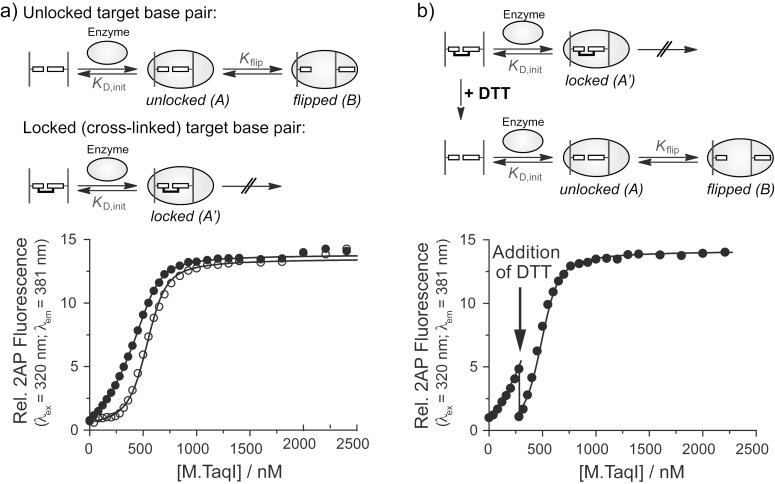Figure 6.
Competition binding of M.TaqI to DNA with unlocked and locked target base pairs. Increasing amounts of M.TaqI were added to a mixture of the DNA of interest and a fluorescent DNA with known KD that contains the target base analog 2-aminopurine (2AP). A more delayed increase in the 2AP fluorescence indicates tighter binding of the non-fluorescent DNA. (a) Binding of M.TaqI to duplex 1I6S∙2U4S with unlocked target base pair (top reaction scheme and open circles) allows base flipping of the target base into the active site. The observed dissociation constant  comprises both the initial binding constant KD,init and the base flipping equilibrium constant Kflip. Binding of M.TaqI to the cross-linked duplex 1I6S-Et-S4U2 with locked target base pair (bottom reaction scheme and closed circles) prevents base flipping, and the observed dissociation constant
comprises both the initial binding constant KD,init and the base flipping equilibrium constant Kflip. Binding of M.TaqI to the cross-linked duplex 1I6S-Et-S4U2 with locked target base pair (bottom reaction scheme and closed circles) prevents base flipping, and the observed dissociation constant  equals KD,init. (b) Switching from locked to unlocked target base pair during the M.TaqI binding experiment. The same competition titration was started with the cross-linked duplex 1I6S-Et-S4U2 in buffer without reducing agent preventing base flipping. Upon addition of DTT (arrow) the cross-link is unlocked enabling base flipping and thus tighter binding. The titration is continued and now follows the binding curve for the duplex with unlocked target base pair.
equals KD,init. (b) Switching from locked to unlocked target base pair during the M.TaqI binding experiment. The same competition titration was started with the cross-linked duplex 1I6S-Et-S4U2 in buffer without reducing agent preventing base flipping. Upon addition of DTT (arrow) the cross-link is unlocked enabling base flipping and thus tighter binding. The titration is continued and now follows the binding curve for the duplex with unlocked target base pair.

